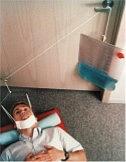Shanghainese pursue greater heights with extreme leg-lengthening surgery.
At Renai Hospital, just across the road from IKEA, Dr. Li Rongguo (李龙国) saws apart his patient’s shin bones and then screws the severed tibias and fibias to external metal braces with pins, rods and wires. After being bedridden for a week with agonizing pain only dulled by heavy sedatives, the patient’s long slow journey begins. Three times a day for up to 16 months, the bone-embedded screws must be manually turned, extending the fracture to encourage new bone growth. This may sound barbaric, but it’s China’s most successful method of leg-lengthening, a surgical procedure which is proving increasingly popular among Shanghainese.
Dr. Li is Renai’s world-renowned director of orthopedics with a medaled military background. Patients are referred to him from all over the world in the hope that he can fix their legs crippled by disease, mangled in
accidents or, in an increasing amount of cases, are simply too short for their owner’s liking. In the past decade, Li has performed over 1,000 leg surgeries, and while he won’t say how many are purely cosmetic, he says the pursuit of height is on the rise. His cosmetic patients range from 20 to 40 years old, divided equally between men and women, most of them with university degrees.
Li says the increasing interest in cosmetic leg-lengthening surgery (接骨再生), which costs around RMB100,000, can be attributed to several factors. “First, people earn more money in China now, so they can afford the surgery,” he says. “Also, my patients mostly have low self-esteem and less opportunity in society. It’s hard for them to find a good job.”
In a country where hundreds of qualified candidates are applying for each vacant position, a minimum height requirement is an effective way for an employer to weed out prospects. A search on Chinese job sites reveals height minimums in many fields. Some companies require their workers, male or female, to be at least 165 cm tall. Sales consultants in some companies are required to be a minimum of 170 cm for men, 165cm for women. A number of Chinese universities have similar height requirements: Hebei University requires journalism students to be at least 170 cm for men, 160 cm for women. Anhui University has a height minimum of 168 cm for men and 158 cm for women who want to major in Chinese language, history, philosophy or media studies. For Shanghai’s police force, men must be at least 168 cm and women 158 cm. More exotic jobs like TV hostesses require a 164 cm minimum.
Li cites another reason for the surgery: love. “Many of my patients undergo this surgery to find love and marriage. You’re considered more attractive in China when you’re taller.”
One of Li’s former patients, Ms. Wang, a 23-year-old woman from Jiangsu who gained seven centimeters in height with surgery, is just one of many of Li’s patients thrilled with the end result.
“It’s amazing. My life is changed forever,” she gushes. Why did she do it? “First, to find love. I have a boyfriend now!“ she says, beaming.
When Wang underwent the surgery in 2008, she kept it from her family. “I didn’t tell my family because I knew they would worry. At the time, I was already living away from home, so I saved my money and got the surgery secretly. I lived in an apartment by myself and studied English for six months as I healed. When I finally came home, the braces scared my parents for a while, but now they’re happy for me.”
Isolation and secrecy is common because the extreme surgery, not surprisingly, is taboo in China. Thus, many patients go through the entire process alone, healing in a cheap apartment near the hospital for six months to a year, occupying themselves, just as Wang did, by learning English or taking online jobs. But a substantial post-puberty growth spurt can’t be concealed forever. When they finally return home, Li says, “Patients often reappear in front of everyone claiming it’s just a miracle that they grew taller.”
Foreigners, too, are having leg-lengthening surgery in Shanghai. Last year alone, 10 foreigners from Germany, the United States, Korea and Japan came to Renai. “I believe China is leading the way in leg-lengthening surgery. Every country has different methods of leg-lengthening, but ours is the most advanced,” says Li, referring to the Micro-Wound method, the procedure used at his hospital.
Pioneered by Dr. Bai Helong (白鹤龙), a member of China’s National Orthopedics Council, the Micro-Wound method is a simplified version of the original pioneered by Russian orthopedic surgeon Gavril Abramovich Ilizarov in the 1950s. In the Ilizarov method, surgeons break the tibia and fibia and then set a stainless steel circular frame around the leg by fixing the top and bottom rings to the bones though tension wires. The frame relieves the fracture site of stress while also enabling movement of the entire leg.
Instead of the cage-like Ilizarov apparatus, the Micro-Wound method uses a simpler fixative clip that covers just one side of the leg. With fewer parts involved, there is less trauma and disturbance of surrounding tissues, nerves and muscles.
Besides Micro-Wound’s successful reputation, another major draw to get the surgery in China is the low cost. The same procedure in the US with a doctor of Li’s caliber would cost US$80,000-140,000 (RMB500,000-900,000).
In November 2006, the Chinese Ministry of Health banned leg-lengthening surgery “for the image conscious.” Ministry spokesman Mao Qunan said at the time, “Leg-lengthening surgery is a clinical orthopedic treatment, not cosmetic surgery… It must only be carried out for strict medical reasons and performed in authorized hospitals.”
One strict medical reason can be height-related stress, according to an orthopedic clinic in Beijing. The clinic’s English website informs prospective patients, “We would like you to keep a low profile about your cosmetic lengthening surgery… When asked by the related authorities (highly unlikely), it will be helpful that you could admit to suffering from height-related stress, so that the surgery is more justified on medical grounds.”
At the time of the ban, unqualified doctors carried out the risky operation in unauthorized beauty clinics. One story recounts a woman, Zhang Wen, who paid a doctor RMB20,000 in Chongqing when she discovered she was just four centimeters short of the 1.6 meter height minimum to be an Air China flight attendant — her dream job. The shady doctor botched the surgery, leaving her with a debilitating limp and not enough money for corrective surgery.
Li claims his success rate is 100 percent and remains in good standing with Chinese Ministry of Health.
Method to the Madness
Dr. Li saws through the tibia and the fibia below the knee without touching the bone marrow, then fixes braces made of nickel and titanium to the legs by screwing them into the bone.
Post-op, the patient is bed-ridden for a week and given painkillers. Patients can usually walk again with elbow crutches after a week. By then the bones begin to regenerate.
After the first week, most patients go off of painkillers, which are thought to adversely affect bone growth. To reduce risk of infection, patients cannot wash their legs and are given antibiotics.
To grow six to eight centimeters, patients must wear braces for one year up to 16 months, manually turning the screws three times daily to extend the fracture 0.55 milli-meters per day.
Every two months, the patient returns to the hospital for X-rays to track if the bones are regenerating evenly. After five months, Li will adjust the brace to ensure even growth.
After desired height is achieved, the patient undergoes a second surgery to remove the braces. The new bone is just strong enough for walking, but the patient should wait another year to do any strenuous activity.
*Photos by Nicky Almasy
 The name of their website is My Lift Kits at myliftkits.com. Looking at the section and variety of products they sell, I would say that the quality and insoles they sell is above average than what you might find from Alibaba or Ebay. The founder is some guy named Derek White who seems to be based off of Hollywood, California.
The name of their website is My Lift Kits at myliftkits.com. Looking at the section and variety of products they sell, I would say that the quality and insoles they sell is above average than what you might find from Alibaba or Ebay. The founder is some guy named Derek White who seems to be based off of Hollywood, California.







 STORY HIGHLIGHTS
STORY HIGHLIGHTS